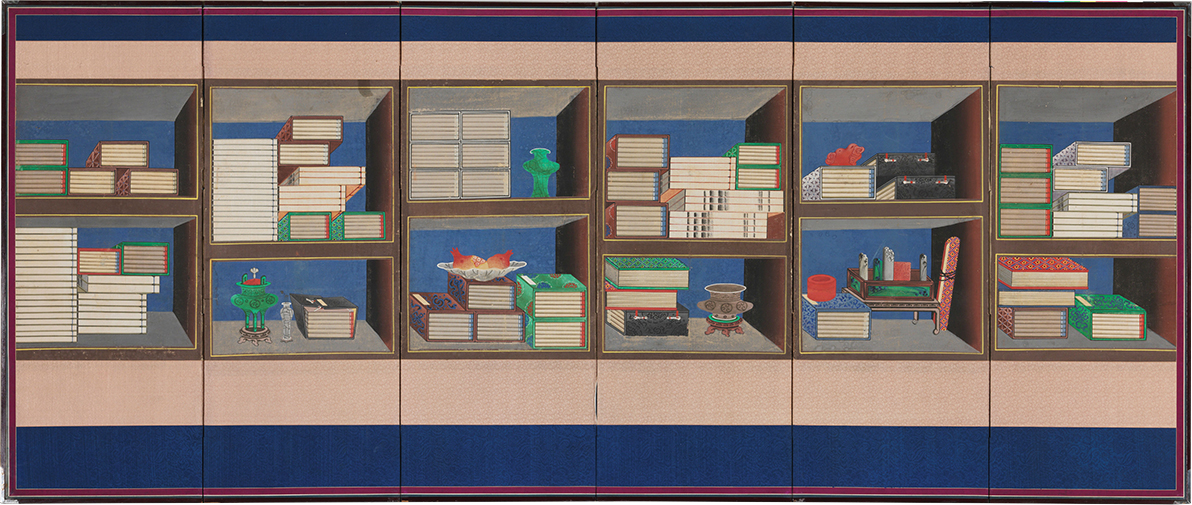
Contents










Crafts · Written by Lee Eun-yi, designer & writer
Folding Screen
Decoration and Practicality
Korea has a rich artistic culture that extends to its unique tradition of folding screens.
Such screens in the past had practical uses such as protection against drafts,
separation of spaces and interior decorations while displaying a host of artworks,
symbolism and religious and folk imagery. Both the legacy and beauty of the screens live
on through the many surviving screens passed on over the centuries.

The eohaedo (fish painting) on this folding screen depicts undersea scenery after Korea’s liberation.© Ansan Fishing Village Folk Museum
The folding screen dates as far back as the era of China’s Han Dynasty (206 B.C.-A.D. 220) and was used widely in the Tang Dynasty (A.D. 618-907). Records say Korea exported such screens to Japan during the reign of King Sinmun, and apparently did so after receiving them from China.
Other records say folding screens were used during Korea’s Goryeo Dynasty (A.D. 918-1392). For example, Xuanhe Fengshi Gaoli Tujing (Illustrated Account of the Xuanhe Embassy to Goryeo), a record of Northern Song Dynasty envoy Xu Jing’s visit to Korea in 1123, said the screens were unfolded in four directions or presented to servants, implying that they were used mostly by the nobility. The screens were also widely used during the Joseon Dynasty (1392-1019), and numerous screens have survived to present day. The diverse uses of a folding screen included protecting against drafts, displaying paintings, embroidery or calligraphy, and separating spaces. The early form was a single-sheet model made of one board, and linking two or more boards led to the development of connecting screens. A screen had two to 12 boards and a two-sheet screen was called a cover or light folding screen. The folding screen was made by pasting paper to the wooden frame, attaching paintings, calligraphy or embroidery, and connecting boards with hinges to allow folding and unfolding.

Produced in the Joseon Dynasty era (1392-1910), the still-life painting chaekgado (scholar’s accoutrements) shows books on bookcases. Its design value has recently seen a resurgence of interest. © National Palace Museum of Korea
Displaying Symbols and Wisdom
The wide variety of folding screens had a range of purposes and styles. Chimbyeong was a screen put by one’s bedside; baeknapbyeong was decorated with paintings and calligraphy; subyeong had an embroidered folding screen; ilwolbyeong was placed behind the king’s seat at the royal court; gojeongdongsubyeong featured embroidery showing bronze cauldrons or bells; jangsaengbyeong displayed images of long-living animals; baekdongjabyeong showed images of children playing; sinseondobyeong promoted Taoist themes; hwajobyeong had pictures of flowers and animals; dojangbyeong displayed the royal seal or signature; seogwondobyeong had books and the four treasures of study painted on it; sansudobyeong featured landscape paintings; and hayansobyeong was used in ancestral rites during the mourning period.
Like in many traditional cultural properties and artworks, paintings on folding screens contained greater symbolism that went beyond simple images. People prayed for fortune by painting or embroidering animals and plants symbolizing wealth, honor and longevity on the screens, and used paintings of books, the Four Treasures of Study (an expression used to denote the brush, ink, paper and ink stone used in Chinese and other East Asian calligraphic traditions) and motivational proverbs to get inspired. Korea has had unique folding screens with short legs that prevent the wooden frame from getting twisted due to the heat from ondol (heated floor). Thus the folding screen served a variety of practical purposes while retaining a high aesthetic sense of both art and symbolism.
Other Articles















